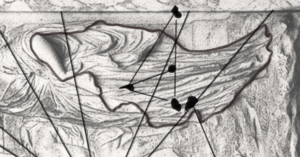It needs to be remembered that the Star Code in its original version is where the stars are referred to by their colours only. This line of coded directional instructions came from the Spaniard Ubilla in 1714 when the treasure was first hidden. It relies heavily upon knowledge of the symbolism of alchemic colours in relation to the opposing positions of the Tetramorphs. This form of the Star Code however was not used by Lord George Anson and Webb as they simply referred to the stars by their names instead. The sole hint in the Anson file of this earlier colour based version even existing is found in the confusion that turned a reference to the star Capella into the landmark of a yellow rock. But as the English had their directions, so also did the Spanish. These directions were used in about 1848 by a Spaniard to raid the cache. Here is where we first learn of this Spanish line of directions and who used them.
Robert Charroux was a French writer who had a Wilkins like taste for the subjects of ancient astronauts and the Atlantean origin of some of the world’s races. ‘Trésors du Monde enterrées, emmurés, engloutis’ was published by Robert Charroux in 1962. In 1966 it was translated into English and the title was ‘Treasures of the World’. It has been said he had an interest in Rennes le Chateau however this interest is the reverse of what is commonly thought; he knew about the real story so his interest in Rennes le Chateau was that of a professional watching some amateurs get it all wrong. ‘Treasures of the World’ contained a Masonic hoax/riddle to be solved regarding Cocos Island as well as some very direct clues about the lost Temple hoard.
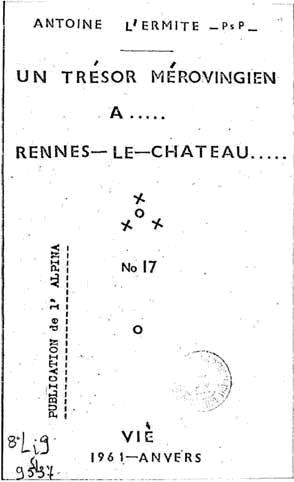
Charroux makes reference to the story of Rennes le Chateau in his book, his source of information being Corbu’s first version. Charroux’s book was then simple copied to make up another of their fake pamphlets called ‘Un Tresor Merovingien a Rennes le Chateau’. The author of this work was supposedly ‘Anotine l’Ermite’ which is literally ‘Anthony the Hermit’.
Charroux founded the ‘International Treasure-Seekers Club’. A picture of them appears in his book. Charroux is at the top with a devilish grin. On his left is Madame de Grazia (Cryptographer) and on her left is Captain Tony Mangel.
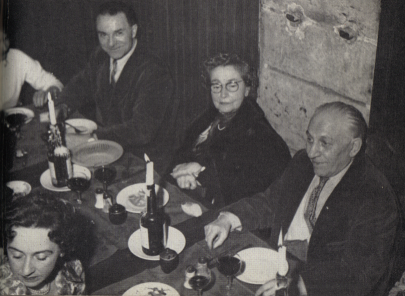
In ‘Treasures of the World’ Captain Tony Mangel tells of his adventure on Cocos Island in 1927. Mangel says he was sailing his yacht, the ‘Perhaps I’ in the “vicinity of Bass Strait” which is the strait between the Australian mainland and its southern island state of Tasmania. Mangel continues,
“At that time I had recently visited the Nautical and Travelers’ Club in Sydney and had been spellbound by the various documents on show under glass and accompanied with explanatory notes. These documents were Keating’s famous letter, registered under No. 18,755, and another document of unknown origin”.
Mangel said he asked for copies of these to made and headed for Cocos Island to land in Wafer Bay for an initial assessment. He said he worked out there had been some error in the original calculations that plotted the location so in 1929 he returned to search the Bay of Hope. The Bay of Hope is on the diagonally opposite side of Cocos Island to Wafer Bay.
Charroux then allegedly quotes the instruction given by ‘Thompson’ to Keating in one of these documents,
“Disembark in the Bay of Hope between islets, in water five fathoms deep. Walk 350 paces along the course of the stream then turn NNE for 850 yards, stake, setting sun stake draws the silhouette of an eagle with wings spread. At the extremity of sun and shadow: cave marked with a cross. Here lies the treasure.”
In related stories the name ‘Thompson’ (or Thomson or Tompson) can be given for the nautical man who died leaving a map to a treasure on an island.
Next Charroux writes,
“Fitzgerald’s letter reiterating the notes left by Keating is preserved at the Nautical and Traveler’s Club in Sydney, registered under No. 18,755. In it the following instructions are given:
“At two cable’s lengths, south of the last watering-place, on three points. The cave is the one which is to be found under the second point.
Christie, Ned and Anton have tried but none of the three has returned. Ned on his fourth dive found the entrance at twelve fathoms but did not emerge from his fifth dive. There are no octopuses but there are sharks. A path must be opened up to the cave from the west. I believe there has been a fall of rock at the entrance.”
This is followed by an inventory “found in the museum of Caracas” which was “left by Fitzgerald at Coiba”. Look for the appearance of the Alchemic colours from the Star Code.
“We have buried at a depth of four feet in the red earth:
1 chest: altar trimmings of cloth of gold, with baldachins, monstrances, chalices comprising 1,244 stones.
1 chest: 2 gold reliquaries weighing 120 pounds, with 624 topazes, cornelian and emeralds, 12 diamonds.
1 chest: 3 reliquaries of cast metal weighing 160 pounds, with 860 rubies and various stones, 19 diamonds.
1 chest: 4,000 doubloons of Spain marked 8. 5,000 crowns of Mexico. 124 swords, 64 dirks, 120 shoulder belts. 28 rondaches.
1 chest: 8 caskets of cedar-wood and silver, with 3,840 cut stones, rings patens and 4,265 uncut stones.
28 feet to the north-east, at a depth of 8 feet in the yellow sand: 7 chests with 22 candelabra in gold and silver weighing 250 pounds, and 164 rubies a foot.
12 armspans west, at a depth of 10 feet in the red earth: the seven-foot Virgin of gold, with the Child Jesus and her crown and pectoral of 780 pounds, rolled in her gold chasuble on which are 1,684 jewels. Three of these are 4-inch emeralds on the pectoral and 6 and 6-inch topazes on the crown. The seven crosses are of diamonds.”
This ‘inventory’ is obviously garbled and its listing of the treasure is similar in form to the Webb report. It is clearly the work of a person who wrote down something they had heard and, after struggling to recall the exact language used and the details that were given, filled out the narration using their own vocabulary. Even so, with the colours red and yellow being quoted, it remains evident that these garbled directions are based on the colour version of the Star Code.
Keating had never voluntarily given the directions to find the treasure. Any directions obtained from him if under duress would not have been so exotic or extensive. It is deduced that Fitzgerald most likely obtained these after he made Keating drunk. Keating afterwards, realising what he had done and in order to cover his indiscretion, maintained to everyone until he died that the directions were for Cocos Island. We have yet to deal with Keating and the full story of the raiders of the Lost Word.
Charroux wrote the chapter on Cocos Island in his book partly as a Masonic hoax/riddle. The ‘Nautical and Traveler’s Club’ never existed in Sydney. What type of club has that many documents archived that its ‘registration’ of them is up to 18,755? That number is given twice in the narrative as it’s a signal to other Masons that Charroux was passing real details to the great lost treasure of God. The trick is to divide 755 by the factor 18. The result is 41.94 (repeated). If this means nothing to you then use the alchemic key to obtain the longitudinal value West of Greenwich; 180-41.9444 = 138.0 degrees. But of course Charroux knew this; he was giving the signal of the Masonic secret number of 42 which you need to solve the puzzle. That and a copy of ‘The Secret of the Unicorn’ by Herge.
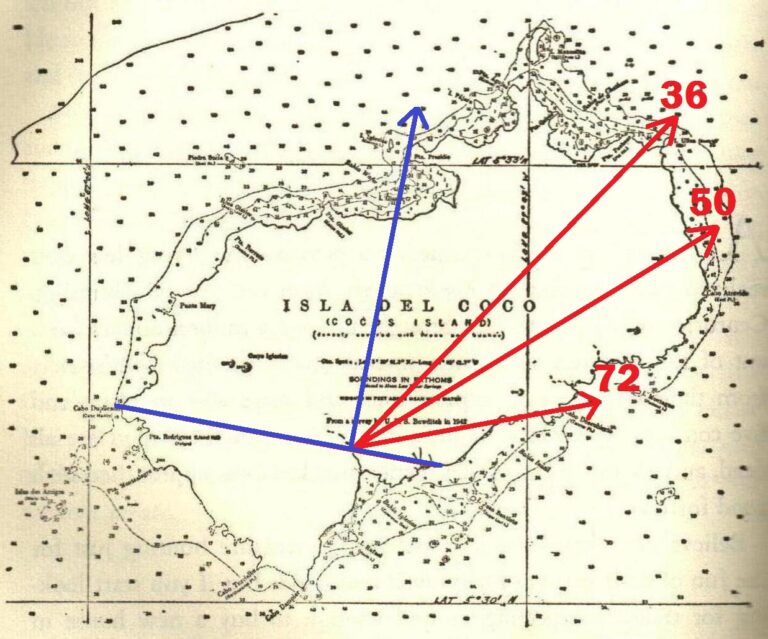
Of course Captain Tony Mangel had a map. His one had a bit more detail that others that directed him to check the Bay of Hope which is on the opposite side of the island to where everyone else searches (Chatham Bay is the most popular destination to search for the treasure on Cocos Island). By doing the plotting you can work out what his map showed. You also might want to compare it with the plottings and coastal features shown on the 25 cent map of Juan Fernandez Island.
Even so, through all the garbling it should be easily recognised now that it was not the headlands of Cocos Island that were not being spoken about by Keating for the direction,
“…..on three points. The cave is the one which is to be found under the second point.”
Robert Charroux’s book was the last one ever to give actual details of the trail to follow to find the Holy Graal.
Instead the world was told that the answer to a great mystery could be found in the book ‘Le Tresor Maudit’ and ‘Holy Blood Holy Grail’.
The result was that everyone spent the next half a century literally without a clue.
*
Now gentle reader, you may have noticed that the riddle of Rennes le Chateau may not have been exposed with the thoroughness that other related legends have been dealt with.
It’s because when the blindingly apparent clues were followed what then turned up was so laughable, for the sake of certain Rennes le Chateau experts’ reputations it won’t then be fully detailed here. It’s just so embarrassingly funny given all the pompous claims that have been handed out for the joint.
(So I don’t want to hear anymore pontification about it from you bunch or I will lay it out in all its humiliating glory.)
That’s not going to stop me though giving some pointers for those who want to learn for themselves who in the Rennes le Chateau talking head zoo just made things up as they went along.
Firstly, it is suggested you start with this Tintin adventure. It’s the one where Tintin and Captain Haddock come across some parchments that enables them to learn ‘The Secret of the Unicorn’.
I’m really not sure how much more obvious they could have made it all. Still…..
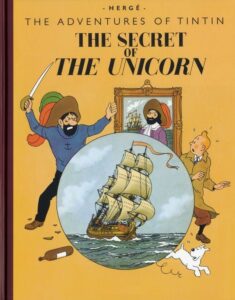
Secondly, you might take heed of the title of Jean Luc Chaumeil’s book ‘The Treasure of the Golden Triangle’.
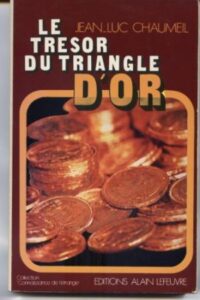
And how it re-iterates the importance of the ‘Dalle Coume Sorde’ alignment that had been promoted during the various re-tellings of the Rennes le Chateau story.
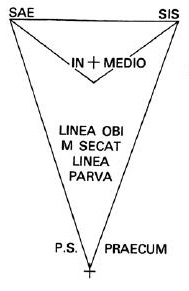
Thirdly, to remind you again how the outline of the shepherdess from a sculpture based on Poussin’s ‘The Shepherds of Arcadia’ painting was used as a treasure map.
Lastly, the 42N latitudinal line.
